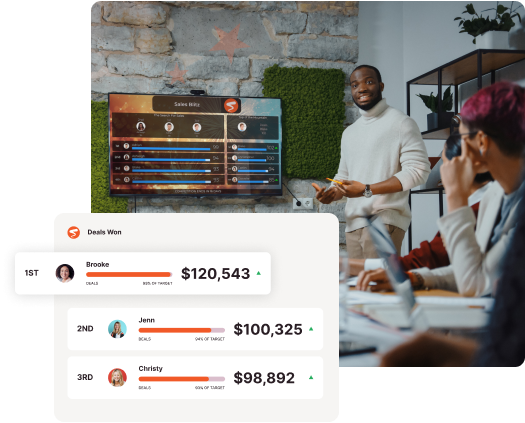Sales is a numbers game, which makes it tough. Your sales team is constantly under pressure to meet targets and quotas. It’s easy to get discouraged, especially when things aren’t going your way.
But what if there was a way to make the whole process fun? What if you could turn hitting your KPIs into a game? That’s where sales gamification comes in.
Think about it this way: when you’re playing a game, you’re laser-focused and determined to win. You’re willing to put in the extra effort because you know it will be worth it. You can apply the same principle to sales.
If you make hitting KPIs feel like a game, your team will be more motivated to achieve them. Adding elements of competition, rewards, and challenges makes reaching your KPIs feel like an exciting adventure instead of a grind.
Ready to learn more? Keep reading to discover how you can gamify your KPIs and take your sales performance to the next level.
What Are Key Performance Indicators (KPIs) in Sales?
Before we dive into gamification, let’s take a step back and review what KPIs are. Do you measure or track your sales team’s performance? If so, you’re already familiar with KPIs.
You use KPIs to track and measure progress toward sales goals. They link day-to-day activities to critical success factors.
For example, suppose your goal is to increase sales by 10% this quarter. You might track the following KPIs to measure progress:
- The number of sales calls made
- Emails sent
- The number of new leads generated
- The number of deals closed
- The value of deals closed
Each of these KPIs can give you valuable insight into how close your team is to meeting your goal. And guess what is even better? You will identify areas that need improvement and take corrective action.
What is KPIs Gamification?
As a sales leader, you likely have a success threshold. To measure your progress towards the desired success, you set KPIs the sales team should achieve. The biggest question is, can you motivate the team to hit and surpass the desired targets?
That would be a breeze if you used gamification. Gamification in sales will allow you to use game-like elements to engage and motivate your sales reps to achieve the set KPIs.
Gamification techniques will help you frame goal attainment as a competition. You can also frame reaching these KPIs as a fun activity.
You will keep your sales reps engaged by allowing them to see their performance. They can compare themselves to their peers based on the benchmarks.
Gamifying KPIs involves the following steps:
- Choosing which sales KPIs to gamify
- Breaking down the KPIs into relevant sales activities
- Building the rules to govern the game
- Determining the software to use to collect data and display performance
- Integrating gamification with KPIs
It’s vital to engage the sales team in most of these steps. For example, they should provide their input on the KPIs to gamify. The reason is that you want to ensure they are ready for sales gamification.
What Are the Benefits of Gamifying KPIs?
The benefits of gamifying KPIs in sales are plenty. By using game-like techniques, you will achieve the following:
- Improved sales performance
- Better team building
- Creating a fun work environment
- Increased employee engagement and motivation
- Increased chances of appreciating your sales reps
- Easy and fun data collection
- Easy identification of where to improve
But achieving these benefits is not automatic. You should design the gamification process well and implement it properly. One tip you shouldn’t forget is that you have to ensure the game is fair.
That’s why you should avoid pitting employees against each other. Why? Because some might feel they are losing and become discouraged.
You should also avoid putting too much emphasis on winning. The goal should be to improve performance, not create a cut-throat environment.
Other Tips to Keep in Mind When Gamifying KPIs
Before you start gamifying KPIs, you should know what works in a gamification program. Here are a few things to keep in mind:
- Prioritize simplicity: The game should be easy to understand and play. Otherwise, you will frustrate your employees, and they will give up.
- Focus on the journey, not the destination: The goal should be to help employees improve their performance consistently. Therefore, you should design the game in a way that allows them to track their progress and see how they are improving.
- Make it social: Games are more fun when played with friends. You can make the game more social by incorporating team-based challenges. Doing so will also promote team-building.
- Don’t exclude anyone: The game should be open to all sales reps. Avoid creating a game in that only a few people can win.
- Choose the right prize: The prize should be something that motivates employees to keep playing. It could be something as simple as bragging rights or a gift card.
How to Gamify Sales KPIs?
And now, for the fun part: gamifying your KPIs to boost sales performance. You can never go wrong with the following initiatives for gamification KPIs:

Create Sales Contests
Have you ever been in a contest? If so, you know how motivating it can be. You strive to do your best to win the prize.
The same applies to sales contests. They will create a sense of urgency and competition among your sales reps.
You can base the contests on any of the KPIs you have set. For instance, you could have a contest for the employee who generates the most number of leads in a week. You can have a contest for the most deals closed or the most products sold.
The options are endless. All you have to do is create a contest that aligns with your business goals and objectives.
You can use the contests to achieve goals for different time frames. It could be quarterly, weekly, or monthly goals.
The contests will help the sales team remain focused on KPIs. The best thing is that they will know what numbers to hit. Depending on their performance, they will know what’s working and what’s not.
They will be more excited and motivated to work. Every time a team member wins, they will feel a sense of accomplishment.
The contests will also help you identify your top performers. You can then give them recognition and incentives. Doing so will motivate the high performers even more.
And don’t forget to make the contest fun. The goal is to create a positive and enjoyable experience for your employees.
Give Rewards When Sales Reps Hit KPIs
The excitement of receiving an award doesn’t fade, no matter how old you are. Everyone loves getting a reward for a job well done.
Rewards create positive reinforcement. When you give prizes to your employees, they will feel appreciated. They will also feel motivated to keep up the excellent work.
When your sales reps hit their KPIs, give them rewards. For instance, you could give them a day off or a gift card. You could also take them out for lunch or dinner.
Employee rewards don’t have to be expensive. They could be simple things like a gift card, extra vacation days, or a paid day off. It depends on your budget and what you think would be most valuable to your employees.
The key is to come up with a reward that will motivate them. The reward should be something the sales team finds valuable.
It should be something they will look forward to receiving. Otherwise, it will not be motivating.
A thoughtful rewards system that you can introduce is a points system. You can use it to track your sales reps’ achievements.
This system is flexible, and you can tailor it to your company’s needs. You can set different KPIs and award different points for each KPI.
For instance, you could award 5 points for every new lead generated. You could award ten points for every closed deal.
You can set a points threshold when you want employees to redeem their points. For example, you could set a threshold of 100 points. Once an employee reaches that threshold, they can redeem their points for a prize.
Use a Leaderboard to Display Sales Results
Who doesn’t love the thrill of competition? A leaderboard will bring out the competitive side of your employees. They will feel motivated to do their best to see their name on the leaderboard.
A leaderboard in sales gamification is a real-time visual representation of how well each employee is performing.
It will help you track and compare the performance of your sales reps. You can use the results displayed to determine who to coach. They will know where they stand in relation to their colleagues.
You can use a leaderboard to track any KPIs you have set. For instance, you could track the number of leads generated or the number of deals closed.
The leaderboard should be visible to everyone in the company. You can display it on a big screen in the office or on your company’s website.
You can also send it out via email. Whatever method you choose, make sure everyone can see it.
You can update the leaderboard daily, weekly, or monthly. Regular updates will ensure that the sales reps can see their progress. The frequency will depend on the KPIs you’re tracking.
For instance, if you’re tracking the number of deals closed, you could update the leaderboard weekly. If you’re tracking the number of leads generated, you could update it daily.
Set Challenges to Motivate Sales Reps
Another way to gamify sales KPIs is to set challenges. These are short-term goals that employees need to achieve.
You could set a challenge for the sales reps to generate ten new leads in a week. Or you could challenge them to close five deals in a month.
You can set different challenges for different employees. Base the challenges on the team members’ skill levels. For instance, if you have a new sales rep, you could set a lower challenge than you would for an experienced sales rep.
You can also set team challenges. These are challenges that the whole team needs to achieve.
For instance, you could set a challenge for the team to make 100 sales calls in a week. You can use challenges to gamify any of the KPIs you’re tracking. The challenges will motivate your sales team because they will know what they want to achieve.
The key is to set realistic sales goals. If the goals are too easy, the employees will get bored. If they’re too hard, they’ll get discouraged. Find the right balance, and you’ll keep your employees motivated.
Make It Easy to Collaborate
A gamification technique that is all competition and no collaboration will not work. Sales is a team sport. Your employees need to be able to work together and have fun.
Make sure your gamification software makes it easy for employees to collaborate. For instance, you could use a chat tool to allow employees to communicate with each other. You could also use a forum where employees can post ideas and give feedback.
Make sure the software you use allows employees to have fun. For instance, you could use a tool that enables employees to share GIFs and memes.
You could also use gamification tools that allow employees to give each other virtual high-fives when they do a good job. The key is to find a balance between competition and collaboration.
If it’s all competition, your employees will get burned out. If it’s all collaboration, they’ll get bored. The best gamification programs make it easy to add both competition and collaboration.
Start Gamifying Your Sales KPIs with Spinify
The old-fashioned sales competition is a thing of the past. Today, gamification is the new way to motivate sales reps. Gamification makes it fun for employees to achieve their KPIs!
Start gamifying your sales KPIs today with Spinify’s gamification software. Spinify helps you create friendly competition in your team and makes performance visible, so everyone knows where to improve.
Spinify’s real-time leaderboards will help you focus your team on the most important KPIs.Book a demo today to see how Spinify can help you boost your sales performance.



